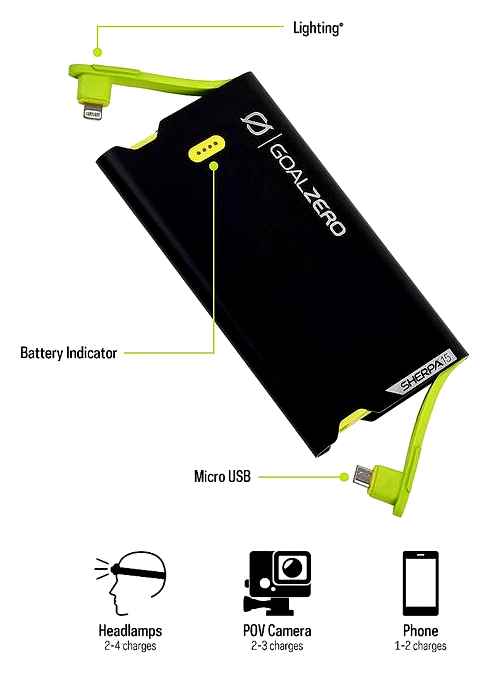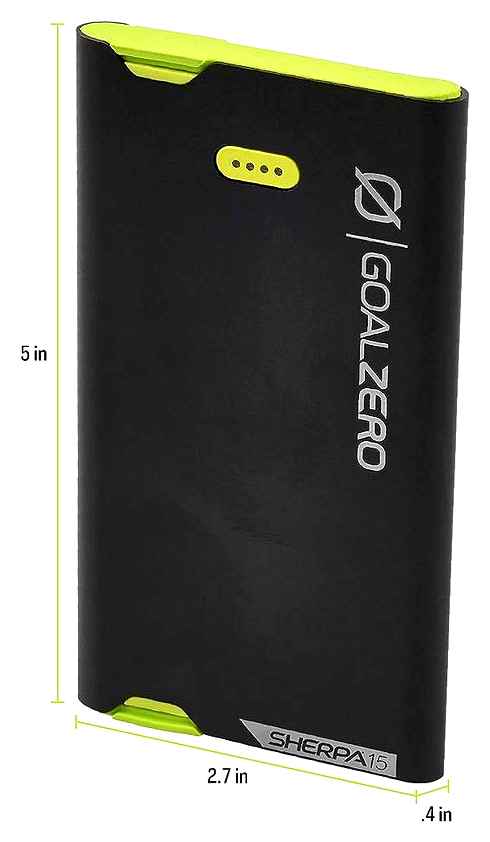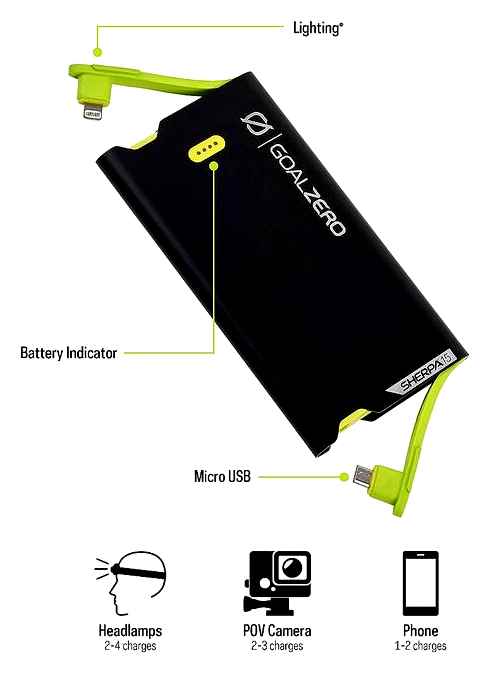Expert’s Rating
The Goal Zero Sherpa 100AC is a combination of all modern and past technologies used to charge our devices. For the current generation of devices, there are two USB-C ports and a Qi wireless charging pad. For older devices, there are two standard USB ports. For even older devices, there’s a standard US 110V outlet—like the one your phone’s wall adapter plugs into.
There’s also a charging port, that can fill up the 94.7Wh battery pack in just a couple of hours. You’ll need to purchase that dedicated charger separately. However, our testing showed that a USB-C wall adapter with Power Delivery charged the Sherpa in just over two hours.
Note: This review is part of our roundup of portable power banks. Go there for details on competing products and our testing methods.

The Sherpa 100AC is pricey. It’s currently listed at 299.95, which is a lot for a battery pack. But the Sherpa isn’t your typical battery pack.
The front of the pack is where you’ll find all of its ports, along with a small display. The screen will show you the battery’s charge percentage, the amount of time until it will die based on the current usage, and a breakdown of each port’s current output.
There are four buttons, two on each side of the screen, for controlling various functions. A power button turns the pack on and off, as well as adjusts the display brightness with multiple presses. The check-mark button is used to change settings. The button with a triangle on it breaks down port usage, or if you press it for about 5 seconds, it takes you to the settings menu, where you can view historical input and output of the pack, change the behavior of the USB-C ports (auto, input, output), and view other system stats. Finally, the Wi-Fi like symbol is used to toggle the wireless charging pad on and off.
The pad is located on top of the pack, directly in the middle. On either side of the pack there’s a slot where you can stash one of the included cables. Included in the box are four cables: Lightning, USB-C, and USB-C to USB-C. Each is just a few inches long, making them portable.
The two USB-C ports are capable of Power Delivery speeds, meaning they can fast-charge the likes of the Pixel 3 XL, or charge a Nintendo Switch thanks to the 60W capability. You can also use the USB-C ports to charge the Sherpa, which I used to test charge speed via the Huawei Matebook X Pro charger. The 65W wall adapter and USB-C cable charged the Sherpa 100AC in 2 hours and 15 minutes. Using the Samsung wall adapter and a USB-C cable, charge time was over 12 hours. The standard USB ports are the typical 5V/2.4A output, so the same as the stock iPhone wall adapter.
I took the Sherpa 100AC on a trip with me recently, toting it around in my backpack. It’s bigger and heavier than most battery packs I carry, but not so much so that I could tell a difference.
The wireless charging pad has a max output of 5W, which is on the low end of the current Qi specs. And I think the emphasis here is on max. In testing the iPhone XS on the pad, it charged the phone’s battery to 28 percent in an hour. That’s the slowest wireless charger I’ve tested yet.
As for overall capacity, I put the Sherpa 100AC through our normal efficiency testing and it output 78.78 percent of its total capacity, putting it in the middle of the pack when compared to other battery packs.
The Sherpa 100AC isn’t for everyone. Its price alone excludes a lot of potential buyers. Instead, it’s built for someone who’s frequently away from outlets, but needs a reliable and fast battery pack, without having to worry about what kind of connections he or she needs. And in that regard, the Sherpa 100AC excels.
Bottom line: If you need a versatile battery pack that you can take in your carry-on bag, and can charge practically any device you own, then the Sherpa 100AC is it.
What is it?
The Goal Zero Venture 75 Power Bank is a lithium-ion battery-powered portable charging unit capable of recharging up to three devices simultaneously via two USB-A ports and one USB-C.
As with most Goal Zero products, the packaging has great visuals and details the capabilities of the Venture 75, highlighting its IP67 rating by showing the unit underwater.
Inside the box, the Venture 75 is tucked safely into a molded cardboard insert which also holds the Venture’s charging cable and user manual.
What’s in the box?
- 2 USB-A ports (output): 5V, up to 3A each (15W max)
- 1 USB-C port (input/output): 5-20V, up to 3A (60W max)
- USB-C PD (60W): 1.5 Hours
- Wall Charger (45W) USB-C: 2 Hours
- USB-A (2.4A): 6 Hours
- Goal Zero Nomad 10: 11-22 Hours
- Goal Zero Nomad 20: 6-11 Hours
- Goal Zero Nomad 50: 6 hours
Design and features
True to form for Goal Zero, the Venture 75 is very well designed with a clear intention of highlighting its ruggedness and utility.
The heavily channeled aluminum body allows for a firm grip even in wet conditions. The heft of the unit is substantial and helps add to the feeling that the Venture 75 can withstand a lot of abuse.

The body is further protected by a slick rubber cover with the Goal Zero logo set into it.
The bottom of the Venture is hard plastic connected to the aluminum body with six inset screws.
The underside of the Venture 75 is covered by more rubber coating with the unit specifications printed on it.
The front of the Venture 75 is hard textured plastic with a thick, clear rubber port plug. The IP67 rating of the Venture 75 is contingent on the port plug being closed. So, with the plug inserted the Venture 75 is fully protected against dust, sand, and debris, and can withstand submersion in up to one meter of water for at least 30 minutes.
This plug just seems so odd to me though. It’s really thick and the labels for the ports are printed on it, so when you open it you don’t see any labels. Not that you need to really, but it just seems weird. I’ll cover this more in the Performance section, but the plug also just kind of hangs there when you’re using the ports. It’d make more sense if the plug tucked into the body somehow or was able to be secured during charging.
When open, the port plug reveals the charging indicator lights, two 5V USB-A ports, and one 60W USB-C port. All three ports can be used to charge devices simultaneously.
The USB-C port is also used to charge the Venture 75 via the included USB-A to USB-C charging cable. The Venture 75 can be plugged in recharging itself while it charges other devices.
The charging cable is pretty short, and unlike some Goal Zero power banks, there’s no place to store the cable on the unit. At 119.95, I had hoped the Venture 75 would include a USB power block, but the cable is all you get.
There’s one button on the Venture 75 front labeled BATT. One press of the button will light up the charging LEDs to indicate battery level. A long press on the button will activate the built-in 50 lumens flashlight. The same long press will shut the flashlight off.
The flashlight isn’t something I’d use on a regular basis, but it does come in handy in a dark tent when fumbling around trying to plug in your devices.
Setup
The only setup needed for the Venture 75 is to charge it before use. New Venture 75 units are shipped in a protective mode to prevent self-discharge caused by long periods of inactivity. Make sure you do this because the Venture 75 will not charge anything until it is plugged into a powered USB port first.
Once plugged in and charging, the blue indicator lights will flash. Each blue indicator light represents 25% battery capacity. When all lights are solid, the unit is at 100% charge. The Venture 75 is designed to be charged from traditional USB power blocks as well as from Goal Zero’s Nomad line of solar panels. While it only takes about 90-120 minutes to fully charge the Venture 75 from a USB power block, it may take anywhere from six to eleven hours to fully charge the unit from one of the Nomad solar panels, depending on which one you use.
Power Capacity
Beyond that, choosing the right power bank is mostly about capacity. Generally speaking, batteries rated with a higher milliAmpere (mAh) will have greater capacity. If your phone uses a 1000mAH battery, then a power bank with a 1000mAH capacity would be capable of charging it about once. By contrast, a 10,000mAH battery would be equipped to fully charge your phone about five times.
But bigger isn’t necessarily better. It’s not hard to find giant batteries on the market, but choosing one adds to the weight of the power bank, not to mention the cost. Choosing the right power bank is about finding the option that’s most appropriate to the kind of power demands you’re planning around. For getting one charge out of one phone, a modest 2000mAH battery would be well suited to the task.
Choosing the right power capacity is a tradeoff. You want to extend the lifespan of your power bank without ending up carrying around a giant weight in the process. That’s because the physical build of the device plays into its portability, including whether or not it’s a hassle to hold and move.
Charging Speed
Another thing to note is the amperage each port on the power bank, which helps determine charging speeds. 2-amps is optimal for charging smartphones, and provides moderately fast charges for tablets. 2.4 amp ports are equipped to handle multiple devices simultaneously, though the charge speed for each individually will suffer. And 5.4 amp ports can charge multiple devices at the highest speeds.
If you’re not sure that your devices will work with a power bank, you’ll want to look at the voltage output of the power bank and ensure it matches up. If the output voltage is lower than the devices you want to charge, it won’t work. But unless you’re using obscure devices with unique power demands, it’s unlikely you’ll run into any of those issues.
Power Connectivity
Most power bank chargers will be USB based. Some of the older designs on the market still make use of ancient ports and cables. But in the case of USB, there’s essentially no reason to look for legacy ports, and essentially no reason to choose older designs. Fortunately, many modern power banks are adapting the latest version of the USB standard. But you’ll still want to know if there’s more than on USB connection, allowing you to charge more than one thing at a time. You’ll also want to know the specific way that you end up making a connection.
Often times, the USB used for charging are built-in to their power bank. Whether or not that’s a good feature mostly comes down to taste. You may enjoy the convenience of always having a cable right there and ready, or it may bug you to death. A similar concern is whether or not an electric socket and a USB cable are the only way it’s possible to charge the power bank. If you’re spending extended periods of time in nature, you might want recharge features that don’t depend on you being among the rest of civilization.
GOAL ZERO Sherpa 100PD Power Bank
It’s our best-selling power bank, slimmed down and dialed. With 94.72 Watts of power delivered to your most crucial devices in a fraction of the time, the Sherpa 100PD is made for action-packed days when every minute counts. Charge USB-C laptops, tablets,
The rating of this product is 0 out of 5
SHERPA 100PD HIGHLIGHTS
Airline approved, travel readyLightweight, sleek design fits easily into packs, bags, and camera cases. Ideal for travel where space is limited.
Charge quickly on the moveFast-charging Power Delivery gives you more power in less time. Charge USB-C laptops, phones, and tablets using the 60W USB-C Power Delivery port. Learn about PD charging.
Ditch the cables if you canCharge your Qi-compatible phone from the integrated Qi charging pad for an entirely wireless experience.
No device left behindTwo 2.4A USB ports are useful for devices with proprietary charging, such as fitness trackers, gps devices, and micro/lightning phones.
TWO WAYS TO CHARGE THE SHERPA 100PD
Recharge from the sun by connecting a compatible solar panel. Charge time is dependent on the size of the solar panel. The Nomad 20 will fully recharge the Sherpa 100PD in about 8-16 hours. NOTE: Sherpa 100PD can only be solar charged using the USB port on our Nomad solar panels.
Use included cables to recharge from a USB source in 8. 10 hours. Fully recharges from the wall in about 3 hours using the 45 Watt USB-C Charger (not included).
